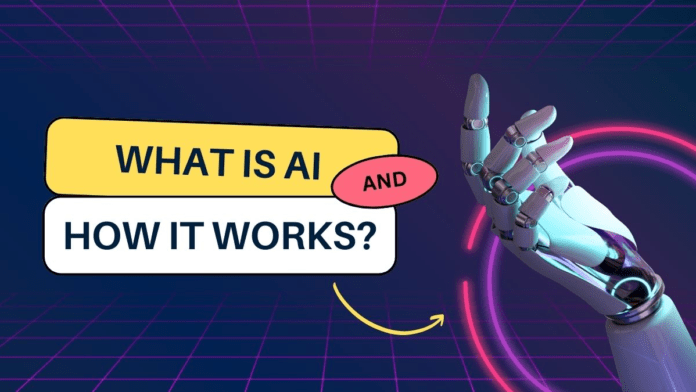Introduction
Artificial Intelligence (AI) has become a buzzword in today’s tech-savvy world. You’ve probably heard it mentioned everywhere, from sci-fi movies to cutting-edge startups. But what exactly is AI and how does it work? In this article, we’ll dive into the fascinating realm of AI, exploring its concepts, functionalities, and real-world applications.
Table of Contents
Understanding Artificial Intelligence (AI)
Defining AI: Beyond Sci-Fi
Artificial Intelligence refers to the simulation of human intelligence in machines that are programmed to think and learn like humans. Unlike the AI portrayed in movies as sentient robots, real AI systems are designed to execute specific tasks and improve their performance over time.
The Two Faces of AI: Narrow and General
AI is often categorized into two types: Narrow or Weak AI, and General or Strong AI. Narrow AI is designed to perform a specific task, like language translation or playing chess. General AI, which remains largely theoretical, would possess human-like intelligence and the ability to understand and perform any intellectual task that a human can.
How AI Works: Unraveling the Magic
The Building Blocks of AI: Machine Learning and Deep Learning
AI’s core functionality lies in its ability to learn from data. This is where machine learning (ML) and deep learning (DL) come into play. Machine learning involves feeding large amounts of data to algorithms that iteratively improve their performance. Deep learning, a subset of machine learning, uses artificial neural networks to model complex patterns in data.
The Role of Data: Fueling AI’s Growth
Data is the lifeblood of AI. The more data an AI system has, the better it can learn and make accurate predictions. For instance, image recognition AI becomes proficient by analyzing countless images to distinguish patterns and features.

Training and Inference: The Learning Process
In the training phase, an AI model learns from labeled data, making adjustments to its internal parameters to improve accuracy. Once trained, the model enters the inference phase, where it applies its learning to new, unseen data, making predictions or decisions based on its training.
Real-World Applications: AI in Action
1. Virtual Assistants: Your AI Companions
Virtual assistants like Siri, Alexa, and Google Assistant are everyday examples of AI in action. These AI-driven systems understand voice commands, answer questions, and even perform tasks like setting reminders or sending messages.
2. Healthcare Revolution: AI’s Healing Touch
AI is transforming the healthcare industry, aiding in the diagnosis of diseases, analyzing medical images, and predicting patient outcomes. This not only enhances medical accuracy but also accelerates the drug discovery process.
Read More: What is Fancraze and How It Works?
3. Driving into the Future: Autonomous Vehicles
Autonomous cars are a prime example of AI integration. They use sensors, cameras, and advanced algorithms to navigate roads, avoid obstacles, and make split-second decisions to ensure passenger safety.
4. E-Commerce Personalization: Your AI Shopping Companion
Ever noticed how online stores recommend products tailored to your preferences? AI algorithms analyze your browsing and purchase history to suggest items you’re likely to be interested in.
The Challenges and Future of AI
Overcoming Bias: The Fairness Challenge
AI systems can inherit biases from their training data, which can lead to discriminatory outcomes. Ensuring AI fairness and eliminating biases is a significant challenge that the industry is actively addressing.
Ethical Dilemmas: AI and Decision-Making
AI’s ability to make decisions raises ethical questions. Who is responsible if an AI-powered vehicle causes an accident? Determining accountability and setting ethical standards for AI usage are ongoing debates.
The Road Ahead: AI’s Evolution
As AI technology evolves, so do the possibilities. General AI, though distant, could revolutionize industries and redefine human-machine interactions. However, it’s crucial to approach its development thoughtfully to harness its potential positively.
Conclusion
Artificial Intelligence is no longer a futuristic concept confined to science fiction. It’s actively shaping our lives and industries, from healthcare to transportation. Through machine learning and deep learning, AI systems learn from data, making them smarter over time. While challenges like bias and ethics persist, AI’s journey is undeniably captivating. So, the next time you use voice recognition or receive a product recommendation, remember that you’re experiencing the marvel of AI in action.
The best AI: ChatGPT
Frequently Asked Questions
Q1: Is Artificial Intelligence the same as automation? No, they’re not the same. Automation involves using technology to perform predefined tasks, while AI involves machines learning and adapting from data.
Q2: Can AI replace human jobs? AI might automate certain tasks, but it can also create new job roles and enhance human productivity.
Q3: What’s the difference between Machine Learning and Deep Learning? Machine Learning is a broader concept involving algorithms that learn from data, while Deep Learning is a subset that uses neural networks to model complex patterns.
Q4: Are there any risks of AI going rogue? AI systems operate based on their programming and data. The idea of AI going rogue like in movies is currently unlikely and more of a speculative concern.
Q5: How can I start learning about AI? You can find numerous online resources, courses, and tutorials to start learning about AI, from introductory concepts to advanced applications.







